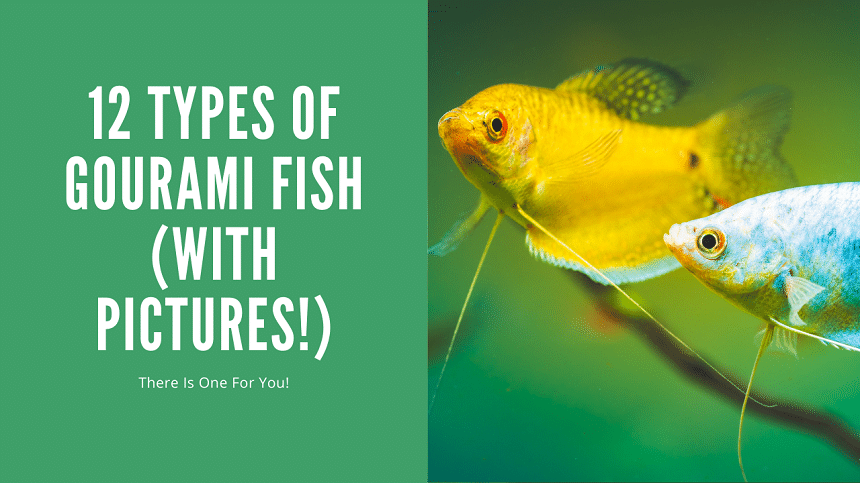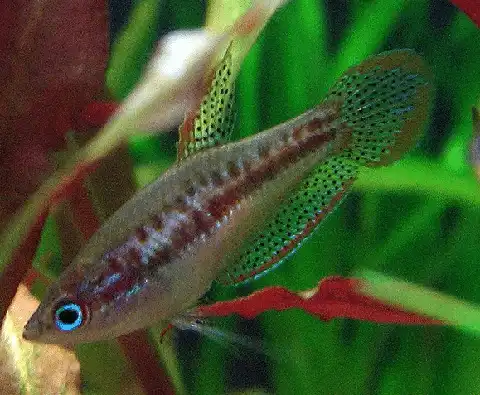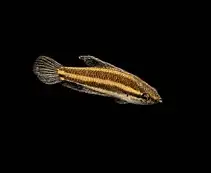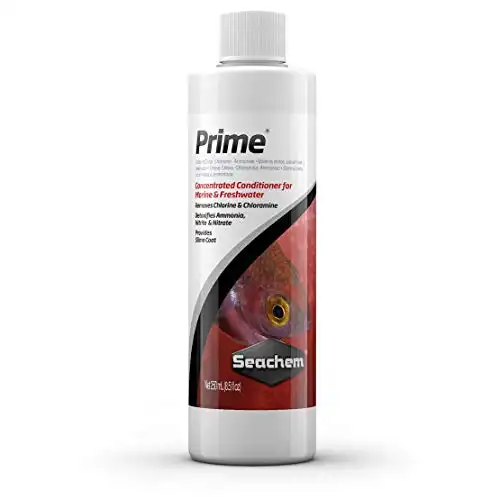Thank you for visiting! By the way… any links on this page that lead to products on Amazon and other stores/partners are affiliate links Aquarium Store Depot earns a commission if you make a purchase.
Gourami fish are some of the most colorful and fascinating tropical fish in the hobby. It’s no wonder that they are so popular amongst fish keepers throughout the world!
In this article, I introduce 14 amazing types of gourami that you can keep in your own aquarium. For all you aquarists who are thinking of starting out with your own gouramis, there’s also some great information about setting up their tank, caring for them, and much more!
What Are Gourami Fish?
Gouramis are freshwater fish from the Osphronemidae family. They originate in South, and Southeast Asian countries, but are such popular aquarium fish that can now be found all over the world. There are over 130 known types of gourami, and many of them are available in the aquarium trade.
Gouramis are known as labyrinth fish because they have a specialized labyrinth organ that allows them to breathe air. Dissolved oxygen levels are typically low in their natural habitat which is why these fish have this special adaptation that allows them to take a breath of air from the water surface.
Gouramis come in all sorts of colors and sizes, from the tiny sparkling gourami at 1.5 inches all the way up to the giant gourami at over 2 feet long! They have distinctive ‘feelers’ which are actually modified pelvic fins.
In the wild, their natural habitats vary from slow-flowing rivers to shallow swampy areas. Gouramis are actually great parents and many species are bubble nest builders.
14 Best Gourami Types For Aquariums
Now that you know a little more about what gourami fish are and where they come from, it’s time to get to know some species! To get you started, I’ve put together this list of the 14 best gourami species for freshwater aquariums that you can keep.
For each species, you’ll find a list of important information to help you choose the best gourami for your tank. That list includes:
- Scientific Name
- Difficulty Level
- Temperament
- Adult Size
- Minimum Tank Size
- Diet
- Origin
- Temperature
- pH
- Difficulty to breed
- Planted tank suitability
I included a video from our YouTube Channel below. If you like it, be sure to subscribe. We upload every week. I go over in more detail in the blog post below.
Let’s get started!
1. Honey
One of the more peaceful Gourami fish available in the hobby. Has a unique yellow coloration and only grows up to 2 inches in length
- Scientific Name: Trichogaster chuna/ Colisa chuna
- Difficulty Level: Easy
- Temperament: Peaceful
- Adult Size: 2 inches in length
- Minimum Tank Size: 15 gallons
- Diet: Feed dried, live/frozen foods
- Origin: India, Bangladesh, Nepal
- Temperature: 72-81°F
- pH: 6-7.5
- Difficulty to breed: Moderate
- Planted tank suitability: Yes
The honey gourami is a great species to start this list! It is a very peaceful fish species that is excellent for beginners. The male honey gourami is much smaller than the female and has bolder colors, but they are both great-looking fish.
Honey gouramis are excellent nano fish that can be kept on their own or in a small group. The honey gourami also makes an ideal tank mate in a community tank if kept with other peaceful fish.
2. Sparkling
A great Gourami for nano tanks. Only grows to 1.5 inches in length
- Scientific Name: Trichopsis pumila
- Difficulty Level: Easy
- Temperament: Peaceful
- Adult Size: 1.5 inches in length
- Minimum Tank Size: 10 gallons
- Diet: Feed dried, live/frozen foods
- Origin: Thailand, Cambodia, Laos, Vietnam
- Temperature: 72-82°F
- pH: 5-7.5
- Difficulty to breed: Moderate
- Planted tank suitability: Yes
The sparkling gourami fish is another terrific nano species that seems to burst with color. Their bold looks are accentuated by the gleaming iridescent turquoise sheen on their body and fins.
Sparkling gouramis are very peaceful fish and can be timid if kept with other fish that are larger and more boisterous than themselves. Ideal tank mates include small schooling fish like rasboras, but avoid keeping them with shrimp as they are quite the little hunters!
3. Licorice
A small gourami that grows to 1.5 inches in length. Prefers to be housed in a planted tank
- Scientific Name: Parosphromenus deissneri
- Difficulty Level: Moderate
- Temperament: Peaceful
- Adult Size: 1.5 inches in length
- Minimum Tank Size: 5 gallons
- Diet: Feed live foods
- Origin: Indonesia
- Temperature: 72-82°F
- pH: 3-6.5
- Difficulty to breed: Moderate
- Planted tank suitability: Yes
The licorice gourami is a spectacular species and one of the few fish that are really suited to nano tanks. These colorful fish don’t need that much room because they stay under 2 inches in length and aren’t very active.
The licorice gourami can be a little tricky to feed because they tend to reject prepared meals like flakes and pellets. This means these tiny fish require daily feedings of live and/or frozen foods like bloodworm, daphnia, and brine shrimp.
4. Pearl

- Scientific Name: Trichopodus leerii
- Difficulty Level: Easy
- Temperament: Peaceful
- Adult Size: 4.5 inches in length
- Minimum Tank Size: 30 gallons
- Diet: Feed dried, live/frozen foods
- Origin: Thailand, Malaysia, Borneo, Sumatra
- Temperature: 75-86°F
- pH: 5.5-8
- Difficulty to breed: Moderate
- Planted tank suitability: Yes
The pearl gourami is a peaceful species that makes a perfect community fish. They are one of the best-looking aquarium fish in the hobby and make an amazing centerpiece fish.
The male pearl gourami is a little more colorful than the female and has extended fins, but both sexes are very attractive and graceful fish. Pearl gouramis are great fish for beginners, and with a lifespan of up to ten years, they make awesome pets.
5. Blue

- Scientific Name: Trichopodus trichopterus
- Difficulty Level: Easy
- Temperament: Semi-aggressive
- Adult Size: 5-6 inches in length
- Minimum Tank Size: 35 gallons
- Diet: Feed dried, live/frozen foods
- Origin: Southeast Asia
- Temperature: 75-86°F
- pH: 5.5-8.5
- Difficulty to breed: Moderate
- Planted tank suitability: Yes
The blue gourami is a beautiful color morph of the popular three-spot gourami. These stunning fish can be pretty aggressive with each other, especially when breeding, and should be regarded as semi-aggressive.
The blue gourami is still a great species for beginners, as long as they have a big enough tank and their territorial temperament is understood.
6. Kissing

- Scientific Name: Helostoma temminkii
- Difficulty Level: Moderate
- Temperament: Semi-aggressive
- Adult Size: 8-10 inches in length
- Minimum Tank Size: 75 gallons
- Diet: Dried foods, spirulina flakes, vegetables
- Origin: Southeast Asia
- Temperature: 71-86°F
- pH: 6-8
- Difficulty to breed: Moderate
- Planted tank suitability: No
The kissing gourami fish is a very odd-looking freshwater aquarium fish! These have puckered mouths, and even come together to lock lips sometimes. This behavior is thought to have social or even breeding functions.
These fish also use their strange mouths for feeding on algae and plants, but they can be kept safely with some tough aquarium plants like Java ferns. Kissing gouramis are another species that can be quite aggressive with other fish, so careful planning is necessary before adding them to community tanks.
7. Giant

- Scientific Name: Osphronemus goramy
- Difficulty Level: Moderate
- Temperament: Peaceful
- Adult Size: 20-28 inches in length (Up to 18 in captivity)
- Minimum Tank Size: 200 gallons
- Diet: Feed pellets, frozen foods, and vegetables
- Origin: Southeast Asia
- Temperature: 68-86°F
- pH: 6.5-8
- Difficulty to breed: Moderate
- Planted tank suitability: Yes
The giant gourami is a huge species that can live for 20 years and makes a great pet. They are very hardy and equally peaceful, although they will eat fish that are small enough to swallow whole.
The giant gourami grows to over 2 feet in length and needs plenty of space. They grow fast too, so make sure you’re ready for the commitment before bringing one of these gentle giants home.
8. Powder Blue Dwarf
Trichogaster lalius «Cobalt» (Male)
— AquaFood (@aquafooduk) March 8, 2020
Price starts from 6.1 GBP
Tag a friend who would love this!
Go and get it at https://t.co/B96kZMDQd6#cobalt #dwarf #gourami #lalius #male #trichogaster#platy pic.twitter.com/rnaiG0W1v6
- Scientific Name: Trichogaster lalius
- Difficulty Level: Moderate
- Temperament: Peaceful
- Adult Size: 2.4-3 inches in length
- Minimum Tank Size: 15 gallons
- Diet: Feed these omnivorous fish dried food, supplemented with live/frozen food
- Origin: India, Bangladesh, Pakistan
- Temperature: 72-82°F
- pH: 6-7.5
- Difficulty to breed: Moderate
- Planted tank suitability: Yes
The powder blue dwarf gourami is quite a sight with its electric blue color and red accents. They can be a good choice for a nano aquarium with the right tank mates.
The powder blue dwarf gourami can be pretty shy and territorial so they should only be kept with other peaceful fish. The females are particularly peaceful and are the best choice for community setups. Alternatively, you can keep these stunning fish in a pair in their own tank, although more fish can be kept in large aquariums.
9. Snakeski

- Scientific Name: Trichopodus pectoralis
- Difficulty Level: Easy
- Temperament: Peaceful
- Adult Size: 8 to 12 inches in length
- Minimum Tank Size: 30 gallons
- Diet: Feed these omnivorous fish dried food, supplemented with vegetables and live/frozen food
- Origin: Southeast Asia
- Temperature: 72-86°F
- pH: 5.8-8.5
- Difficulty to breed: Moderate
- Planted tank suitability: Yes but might nibble on plants
The snakeskin gourami, or snakeskin fish, is about the most peaceful gourami species out there, but they are also probably the least colorful. They are pretty large fish that need plenty of space to thrive.
The snakeskin gourami makes a wonderful community fish, but it is important to note that they may swallow smaller fish and there is a possibility of your plants getting snacked on too!
10. Gold
- Scientific Name: Trichopodus trichopterus
- Difficulty Level: Easy
- Temperament: Semi-aggressive
- Adult Size: 5-6 inches in length
- Minimum Tank Size: gallons
- Diet: Feed dried, live/frozen foods
- Origin: Southeast Asia
- Temperature: 75-86°F
- pH: 5.5-8.5
- Difficulty to breed: Moderate
- Planted tank suitability: Yes
The gold gourami (like the blue gourami) is a variant of the three spot gourami species. These eye-catching fish are a rich golden yellow color with beautiful marbling and spots on their fins and body.
Gold gouramis (video source) have the same care needs as blue gouramis, as well as the regular three spot gourami and opaline gourami. This is because they are all different color variations of the same species.
11. Moonlight

- Scientific Name: Trichogaster microlepis
- Difficulty Level: Moderate
- Temperament: Peaceful
- Adult Size: 6 inches in length
- Minimum Tank Size: gallons
- Diet: Feed these omnivorous fish dried food, supplemented with vegetables and live/frozen food
- Origin: Vietnam, Cambodia, Thailand
- Temperature: 77-86°F
- pH: 6-7.5
- Difficulty to breed: Moderate-advanced
- Planted tank suitability: Yes
The moonlight gourami might have a little less color than some of the other species on this list but it makes up for it with an amazing silvery-blue/green shine! They also have extra-long feelers (pelvic fins) which are bright red in males.
Moonlight gouramis do great in community tanks with other peaceful species and can be kept in pairs or small groups in a big enough tank.
12. Sunset
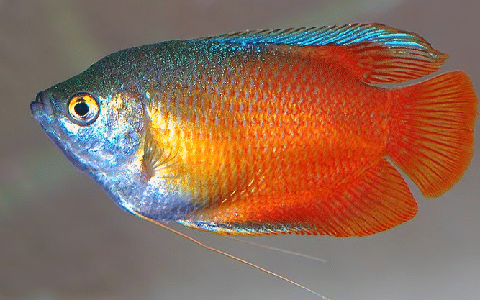
- Scientific Name: Trichogaster labiosa
- Difficulty Level: Easy
- Temperament: Peaceful
- Adult Size: 4 inches in length
- Minimum Tank Size: 15 gallons
- Diet: Feed these omnivorous fish dried food, supplemented with live/frozen food
- Origin: Myanmar
- Temperature: 72-82°F
- pH: 6-7.5
- Difficulty to breed: Moderate
- Planted tank suitability: Yes
The sunset gourami is one of the best gouramis for a community tank. These golden orange fish can be kept in groups without aggression between themselves or their tankmates.
The sunset gourami is often confused with the sunset variety of the honey gourami, so be sure your fish is correctly labeled!
13. Flame Dwarf
- Scientific Name: Trichogaster lalius
- Difficulty Level: Moderate
- Temperament: Peaceful
- Adult Size: 2.4-3 inches in length
- Minimum Tank Size: 15 gallons
- Diet: Feed these omnivorous fish dried food, supplemented with live/frozen food
- Origin: India, Bangladesh, Pakistan
- Temperature: 72-82°F
- pH: 6-7.5
- Difficulty to breed: Moderate
- Planted tank suitability: Yes
The flame dwarf gourami (video source) is a very special breed of the popular dwarf gourami. These fish have spectacular colors and differ from the regular dwarf gourami in having more solid coloration. The body color of the flame gourami is a brilliant golden orange in contrast to the dorsal fin which is electric blue. Dwarf gouramis can also make good tankmates for angelfish.
14. Blue Paradise
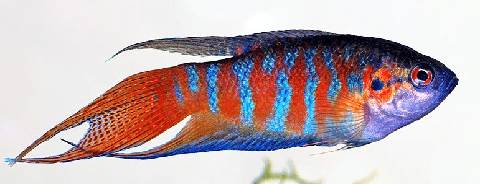
- Scientific Name: Macropodus opercularis
- Difficulty Level: Moderate
- Temperament: Semi-aggressive
- Adult Size: 3 inches in length
- Minimum Tank Size: 20 gallons
- Diet: Feed live/ frozen foods, might also accept high quality dried foods
- Origin: Vietnam, Laos, China, Taiwan
- Temperature: 50-71°F
- pH: 6-8
- Difficulty to breed: Moderate
- Planted tank suitability: Yes
The blue paradise gourami is a feisty little species that is also known as the paradise fish. What sets these fish apart is their tolerance for cooler water, so they can usually be kept in an unheated aquarium.
Paradise fish have amazing color, but they can be pretty aggressive around breeding time. The ideal stocking is one male with two or more females because males kept together will fight.
Tank Setup
The different types of gourami vary greatly in size, so selecting the right tank size depends on the species you keep.
Some dwarf species like the sparkling gourami will do great in a ten gallon tank, while the giant gourami will need 250 gallons or more. Most average-sized species, like the pearl gourami, for example, will do best in a 30-gallon tank or larger.
Substrate & Decorations
Your choice of substrate is not all that important when it comes to keeping gouramis. Any well-rinsed aquarium substrate of your choice will work fine.
If you plan on growing live rooted aquarium plants, you may wish to use quality aquarium soil, but otherwise, gravel or aquarium sand will work just fine. I would suggest using darker natural colors to make the fish’s color stand out and help them feel more comfortable.
Gouramis can be quite shy and are easily stressed in an empty tank without decorations. This affects how your fish feel and also how they look because stressed gouramis will not show their best colors.
Use some driftwood or rocks to create some structure in the aquarium. Large aquarium ornaments are also very useful, just be sure to avoid anything with sharp edges.
Editor's Choice
Manzanita offers it all. Great shape, low tannins, quick to water log and reasonably priced. It's the ultimate driftwood!
Live Plants
Gouramis love a heavily planted tank. Aquatic plants actually have a number of great benefits for your aquarium because they help to oxygenate the water while removing excess nutrients.
Furthermore, live plants provide natural food sources and structure for your fish to explore and hide in.
Not all aquarium plants are suitable for beginners, but the following species can be grown without any specialized equipment:
- Cryptocoryne
- Java fern
- Anubias
- Vallisneria
Floating plants are great because they help to make your gouramis feel more comfortable in the aquarium, but they can pose a threat to your fish.
Gouramis often rise to the top of the aquarium to breathe air with their labyrinth organ, so it is crucial that they can get to the surface. Make sure your floating plants don’t cover the water’s surface completely.
If you’re interested in growing a wider range of plants, check out some of my plant profiles for great tips!
Lighting & Filtration
Most gouramis will usually be more confident in lower light situations. Bright lighting in a heavily planted tank is perfectly fine, however, because dense plant growth will provide the fish with plenty of cover and shade.
Gouramis are usually found in still or slow-flowing water bodies, so it is important to keep the water flow down in the aquarium. You can do this by running a sponge filter, but there are also ways to manage the current generated by a power filter or hang-on back design.
The Best Aquarium Power Filter
The worlds best selling and most reliable power filter on the market. Unchanged for years because it's so reliable and versatile
Most power filters have adjustable water outputs so you can slow the current. You can also aim the outflow at a hardscape feature like driftwood or rocks to break up the water flow. Running a spray bar with a canister filter is another great way to keep the water current gentle.
Care
Gouramis are relatively easy to care for if you start out with the right kind of setup. That’s not all these fish need to thrive, however, so read on for more details on their behavior, feeding, and care needs.
Aquarium Maintenance
No guide to aquarium fish care would be complete without mentioning aquarium maintenance. Follow these steps to keep your fish healthy and your aquarium looking great!
You’re going to need to perform a weekly or twice monthly water change to manage the nitrates in your water and remove all the solid waste particles that have settled on the substrate, hardscape, and plants.
To do this, you’ll need a gravel vacuum to suck up the waste and the old water. Remove 10-25% of your water during each change and be sure to test for nitrates before and after with your water test kit. Ideally, you want to keep your nitrate levels down to 20 ppm or less.
Before adding new water to the tank, make sure it is at a similar temperature to the old water, and use a conditioner to neutralize any harmful chemicals dissolved in your tap water.
Seachem prime is a easy to use and affordable choice when it comes to remove chlorine and chloramines from your tap water. Highly recommended!
Behavior & Feeding
Most types of gourami are peaceful fish, but some can be semi-aggressive around breeding time. Do not keep more than one male in the same aquarium unless it is a very large tank, as they tend to become territorial and fight when space is limited.
The more aggressive species to note are:
- Kissing gourami
- Three spot gourami
- Blue paradise gourami/ paradise fish
Although it shouldn’t be seen as aggressive behavior, some of the larger species might snack on smaller fish and fry if they can. Freshwater shrimp can also be part of the menu.
Most gouramis are omnivorous, which means they feed on both plant and animal matter. Smaller species like the licorice gourami and chocolate gourami are predators that feed on small invertebrates.
Most species will thrive on a diet of prepared dried foods, supplemented with frozen and live foods and vegetables. These supplements improve the general health of the fish, and you will see this by the enhanced colors they develop.
Some of the more specialized species like the chocolate gourami can be more challenging because they usually don’t accept prepared foods and require live or frozen foods on a daily basis.
Breeding
Gouramis are fairly easy to breed and make a great breeding project. Let’s take a closer look at how to breed these fish in the home aquarium.
Before attempting to breed your fish, it is very important to get them in top physical condition. You can do this by improving their diet with more live foods and vegetables. A healthy, well-conditioned pair can then be moved to a breeding tank.
It can be tough to tell female gouramis from males. The female will look heavier when she is in breeding condition and carrying eggs.
The males often have more pointed fin margins than the females. In some species, like the honey gourami, the male is a lot more colorful.
A shallow breeding tank of just 6 inches or so is the ideal setup. The water flow should be slow so an air-powered sponge filter is an ideal choice for this low water volume. The water in the breeding tank should be on the warm side, in the lower 80’s Fahrenheit.
Most gouramis are bubble nesting fish. The bubble nests are built by the male, and after spawning, he will collect the eggs and attach them to the underside of the nest. At this point, you can move the female out of the breeding tank, her side of the job is done!
These fish build their bubble nests on floating plants in nature, and this works great in the aquarium too. They will attach their nests to other floating objects, however, and many aquarists have had success with simple pieces of foam.
Once the eggs have hatched, you can feed the free-swimming fry infusoria, baby brine shrimp, and other food sources like prepared liquid fry foods.
Tank Mates
Most types of gourami will do great in a community tank with other community fish. Choosing compatible and peaceful tank mates is always important of course.
Suitable tank mates should be similar-sized fish that they cannot swallow, or be swallowed by! Aggressive fish and fin nippers should also be avoided.
Some types of gourami will do best when kept in a species-only setup without other fish. The following species make ideal tank mates for the more peaceful gouramis:
- Cardinal tetras and other schooling fish
- Dwarf cichlids
- Corydoras catfish
- Otocinclus catfish
- Danios
- Rasboras
- Loaches
Where To Buy
Gouramis are some of the most popular freshwater fish in the aquarium hobby, so they are usually pretty easy to find. You can take a look at your local fish store or simply order your fish online.
Buying livestock online is easier than ever these days, and trusted retailers in the field like Flipaquatics.com stock a great range of gouramis at great prices!
FAQS
How many should be kept together?
Sometimes it is best to keep just one gourami in a tank to avoid the chance of aggression – it all depends on the species.
This is especially true with males. Females gourami fish tend to be much more peaceful so it is often possible to keep a small group together.
How many of the dwarf variety should be kept together?
It is best to keep just a pair of dwarf gouramis in the same tank. This is because some individuals do become a little territorial and aggressive. It is possible to keep more in a large aquarium with plenty of plants and cover, however.
What is the most aggressive?
The paradise fish is probably the most aggressive gourami. The popular three-spot gourami (blue gourami, gold gourami, opaline gourami, etc. ) also has some aggressive tendencies, especially around breeding time.
Are they aggressive?
Gouramis are generally peaceful fish, but some species can be semi-aggressive. Most fighting happens between male gouramis, so it is often safer to avoid keeping two males in the same aquarium.
What is the smallest variety?
Sparkling gouramis and licorice gouramis are the smallest species you are likely to come across in the hobby. These nano fish reach about 1.5 inches when fully grown.
Final Thoughts
Gouramis are awesome and often underrated tropical aquarium fish. There are so many types of gourami to choose from that there is a species or breed to suit just about any tank! If you’re looking for some new centerpiece fish or even an interesting breeding project, why not pick up a pair of these awesome fish for your aquarium?
Do you love gouramis as much as we do? Tell us about your favorite fish below!
- About the Author
- Latest Posts
I’m thrilled that you found Aquarium Store Depot! Here you’ll find information on fish, aquariums, and all things aquatics related. I’m a hobbyist (being doing this since I was 11) and here to help other hobbyists thrive with their aquariums! I adhere to a high quality Editorial Process and Review products with real life field usage and practical analysis.

